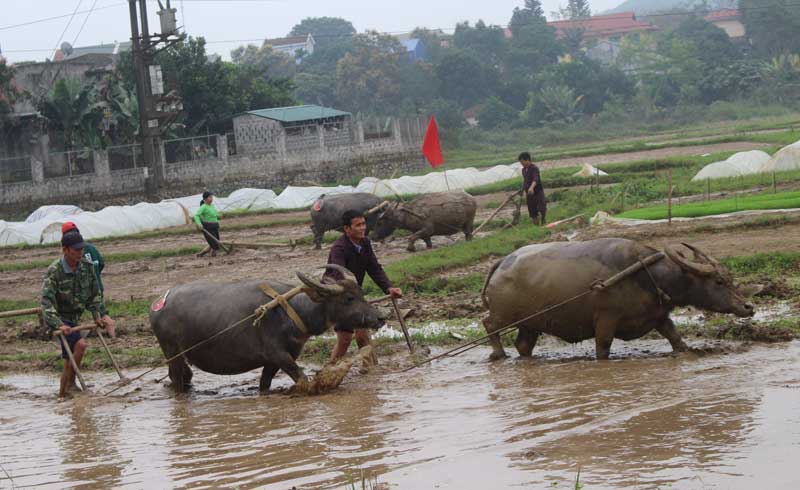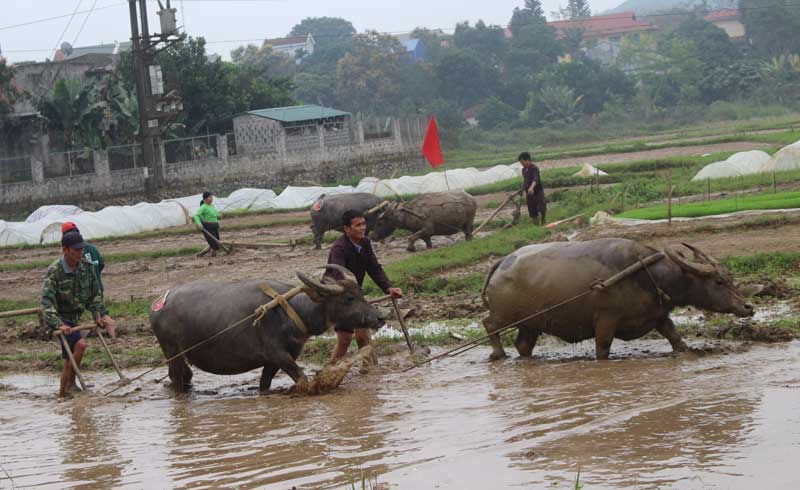
(HBO) - In Muong villages, the buffalo image is always attached to farmers. According to the farmers in Muong villages, plowing and harrowing with buffaloes helps the soil better and helps the rice less susceptible to pests and diseases. Therefore, the people in Muong Bi (Tan Lac) still maintain plowing, harrowing and preparing oil for rice cultivation with buffaloes.
 The teams performing the rituals of plowing in early spring
at Khai Ha ceremony in Muong Bi in 2020.
The teams performing the rituals of plowing in early spring
at Khai Ha ceremony in Muong Bi in 2020.
In order to reappear the rituals of plowing in the early
spring, every year at Kha Ha ceremony in Muong Bi, the Party Committee, the
authorities of Tan Lac district organize the plowing ceremony at the beginning
of spring with the expectation that Muong Bi fields are lush and paddy, the
dunes are full of rice, the people are always full, the villages are peaceful
and all things multiply throughout the new year. However, today the ritual is
more innovative.
The number of buffaloes and participants taking part in the
plowing ceremony has been increasing. The plowing competition in early spring
has been organized in the locality... Thereby, the plowing rituals of in the
early spring has become a unique cultural activity, attracting a large number
of people to participate. At Khai Ha ceremony in Muong Bi the year of Rats in
2020, there were 5 plowing teams with of 2 people and 2 buffaloes taking part
in the competition. Buffaloes participating in the ceremony must be big and
strong, regardless of male or female buffaloes. The plow is firm, sharp and
beautiful. The plowmen must be skilled.
In order for the plowing rituals to be done carefully, Phong
Phu commune has selected good buffaloes in the hamlets and chosen each person
to implement the plow. Through many rounds of selection, 10 good buffaloes
meeting all criteria were trained and cared for to perform the rituals in the
morning of the 8th of January of the year of the Rats.
Mr. Bui Trong Que, in Man hamlet, in Phong Phu commune says:
Our family is very happy when our buffalo has been chosen to participate in the
ceremony. I am honored to be the one to make the first plows in the new year.
Before the Lunar New Year of the Rat, we had to fatten the buffalo so that he
becomes fat and healthy to make fast and straight plows. The first straight
plows of the New Year's promise a year of green and paddy fields of rice.
With an increasingly vibrant and widespread emulation movement aimed at building cultured residential areas and cultured families, Yen Thuy District has been making steady progress toward improving both the material and spiritual well-being of its people, while fostering a civilized, prosperous, beautiful, and progressive community.
Once lacking recreational spaces and community facilities, Residential Group 2 in Quynh Lam Ward (Hoa Binh City) has recently received attention for the construction of a new, spacious, and fully equipped cultural house. The project followed the model of state support combined with public contributions in both labor and funding.
The "All people unite to build cultural life" movement, which has been effectively integrated with Kim Boi district’s socio-economic development goals, is fostering a lively spirit of emulation across local residential areas, hamlets, villages, public agencies, and enterprises. In addition, through the initiative, traditional cultural values are being preserved and promoted, while community solidarity and mutual support in poverty reduction and economic development are being strengthened.
A working delegation of the Hoa Binh provincial People’s Committee led by its Permanent Vice Chairman Nguyen Van Toan on June 11 inspected the progress of a project to build the Mo Muong Cultural Heritage Conservation Space linked to tourism services in Hop Phong commune, Cao Phong district.
Born and growing in the heroic land of Muong Dong, Dinh Thi Kieu Dung, a resident in Bo town of Kim Boi district, in her childhood was nurtured by the sweet lullabies of her grandmother and mother. These melodies deeply imprinted on her soul, becoming an inseparable part of her love for her ethnic group's culture. For over 20 years, this love for her hometown has driven Dung to research, collect, and pass down the cultural values of the Muong people to future generations.
In the final days of May, the Ethnic Art Troupe of Hoa Binh Province organized performances to serve the people in remote, mountainous, and particularly disadvantaged areas within the province. These were not just ordinary artistic shows, but they were the meaningful journeys aimed at spreading cultural values, enhancing the spiritual life of the people and contributing to the preservation of ethnic minority cultural identities.



 The teams performing the rituals of plowing in early spring
at Khai Ha ceremony in Muong Bi in 2020.
The teams performing the rituals of plowing in early spring
at Khai Ha ceremony in Muong Bi in 2020.